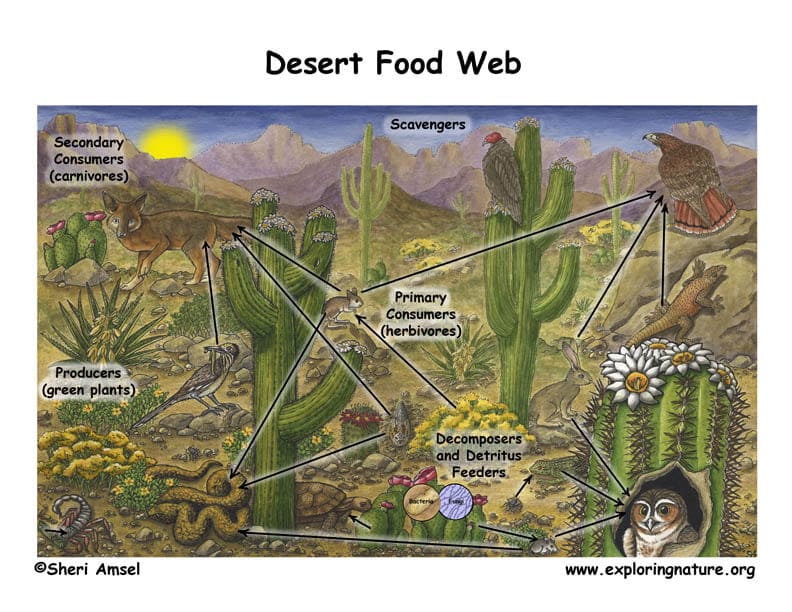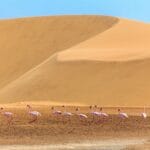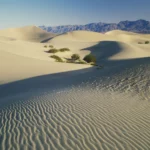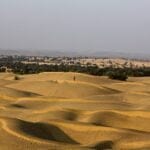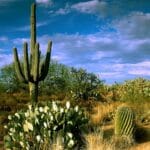In the heart of arid, seemingly barren landscapes, a world of resilience and adaptation thrives. Desert producers, the unsung heroes of these ecosystems, defy the odds, demonstrating nature’s remarkable ability to flourish in the face of adversity. These plants, from iconic cacti to resilient shrubs, are not just survivors; they are the foundation of a complex web of life that depends on their ability to convert sunlight into energy.
Desert Producers: The Unsung Heroes of a Thirsty World
When we imagine a desert, images of scorching sun, endless sand dunes, and a struggle for survival often come to mind. Yet, this challenging environment belies a hidden world teeming with life, all thanks to the remarkable adaptations of desert producers. These plant powerhouses, including cacti, shrubs, and even certain resilient trees, have evolved ingenious strategies to not only withstand the harsh conditions but to form the bedrock of the desert food chain.
Consider the cactus, an enduring symbol of desert life. Its ability to store water in its thick stems is a testament to evolutionary ingenuity, enabling it to weather extended periods of drought. Similarly, desert shrubs often sport thick, waxy leaves, acting as natural raincoats to minimize water loss through transpiration. These adaptations are not merely fascinating quirks of nature; they are the very reason entire ecosystems can exist in these demanding environments.
Desert producers, through the magic of photosynthesis, convert sunlight into usable energy, just like their counterparts in more temperate climates. However, in the harsh desert landscape, this process takes on a special significance. This energy, painstakingly produced, ripples outwards, sustaining a surprising diversity of life. From tiny insects to grazing mammals and the predators that rely on them, the entire desert food web hinges on the productivity of these unsung heroes.
The presence of these producers dictates which animals can survive, influences the soil’s health, and even impacts how the entire ecosystem responds to change. Their role extends far beyond simply existing; they orchestrate the delicate balance of life in one of Earth’s most extreme biomes.
Protecting these desert heroes is more critical now than ever. Human activities, such as the introduction of invasive species, alteration of landscapes, and contribution to climate change, are putting increasing pressure on these resilient ecosystems. Research suggests that rising temperatures, for instance, might favor certain plant species over others, potentially leading to unforeseen and potentially detrimental changes in the entire ecosystem. Understanding these complex relationships is vital to ensuring the long-term health of our deserts.
What are 5 primary consumers in the desert?
The desert, often perceived as a quiet and desolate expanse, teems with a surprising array of life. At the heart of this delicate ecosystem are the primary consumers, the herbivores that form the critical link between the producers (plants) and the higher levels of the food chain. These creatures, diverse in their adaptations and strategies for survival, play a crucial role in maintaining the delicate balance of this unique environment.
One of the most iconic desert dwellers is the kangaroo rat, a master of water conservation. These small rodents, with their characteristic large hind legs and long tails, have evolved to extract moisture from their food, requiring minimal water intake. Their diet consists primarily of seeds, which they collect and store in their cheek pouches, making them essential players in seed dispersal.
Insects, often overlooked but ever-present, play a crucial role as primary consumers in the desert. From beetles and grasshoppers to ants and termites, these tiny creatures feed on a variety of plant matter, breaking down organic material and contributing to nutrient cycling. Their abundance and diversity make them a vital food source for many insectivorous animals higher up the food chain.
Lizards, with their diverse array of shapes, sizes, and adaptations, are another key group of primary consumers. Some, like the iconic desert iguana, are primarily herbivorous, their strong jaws and teeth well-suited for consuming tough, fibrous plant material. Others, like the chuckwalla, have adapted to feed on a mixed diet of plants and insects, highlighting the adaptability and resourcefulness of desert life.
Perhaps the most iconic desert reptile, the desert tortoise, embodies resilience and longevity. These ancient creatures, with their slow, deliberate movements and ability to survive for months without water, are herbivores, grazing on a variety of plants, including cacti, grasses, and wildflowers. Their burrows provide shelter not only for themselves but also for a variety of other desert creatures, highlighting their importance in the ecosystem.
Lastly, we can’t forget the rabbits, particularly the black-tailed jackrabbit, a common sight in deserts across North America. These agile herbivores, with their long ears and powerful hind legs, are adapted for both speed and endurance, enabling them to cover vast distances in search of food and escape from predators. Their diet consists primarily of grasses, shrubs, and other vegetation, making them important players in shaping plant communities.
The intricate relationships between these primary consumers and their environment are a testament to the delicate balance of nature. Scientists are continually uncovering new insights into their ecological roles and the potential impacts of environmental change on their populations. Understanding these relationships is crucial for ensuring the long-term health and biodiversity of these remarkable ecosystems.
What Plants are in the Desert Food Chain?
Desert ecosystems, often perceived as desolate and unforgiving, harbor a surprising abundance of life, all sustained by the remarkable adaptations of desert plants. These plants, the primary producers of this unique food chain, form the foundation upon which all other life depends.
Cacti, the iconic symbols of the desert, stand as testaments to nature’s ingenuity. Their swollen stems, protected by spines to deter thirsty animals, serve as reservoirs for precious water. Succulents, another group of desert dwellers, employ similar water-saving strategies, their thick, fleshy leaves storing moisture to endure extended periods of drought.
But the desert’s botanical repertoire extends far beyond these water-hoarding specialists. Shrubs, often low-lying and with deep root systems to tap into underground moisture, dot the landscape. These plants, with their tough leaves and often-thorny defenses, provide both sustenance and shelter for a variety of desert dwellers.
These desert plants, through the process of photosynthesis, convert sunlight into usable energy, forming the base of the desert food web. This energy then flows upwards, supporting a diverse array of consumers. Insects, reptiles, birds, and mammals all rely, either directly or indirectly, on the productivity of these desert plants.
For example, a kangaroo rat might feast on the seeds of a desert shrub, only to become a meal for a rattlesnake, which in turn might fall prey to a Red-tailed Hawk. Each organism in this intricate web plays a vital role in maintaining the delicate balance of the ecosystem.
However, the desert food web, like all ecosystems, faces increasing pressure from human activities. Climate change, habitat fragmentation, and invasive species all threaten the delicate balance of these unique environments. Understanding the interconnectedness of desert life, from the seemingly insignificant plants to the apex predators, is paramount to ensuring the long-term health and biodiversity of these remarkable ecosystems.
What are the producers in the cold desert?
Cold deserts, characterized by their frigid temperatures, low precipitation, and often-stark beauty, might seem like unlikely places for life to thrive. Yet, even in these harsh environments, a remarkable array of producers forms the foundation of the food web, demonstrating nature’s remarkable ability to adapt and persist.
While cacti might dominate the imagery of hot deserts, cold deserts boast their own unique suite of plant life. Low-lying shrubs, often with small, leathery leaves to minimize water loss, hug the ground, taking advantage of the limited moisture available. Their root systems, often extensive and deep, tap into underground water sources, anchoring them against the harsh winds that often sweep across these landscapes.
Grasses, too, play a crucial role in cold desert ecosystems. These hardy plants, often dormant during the harshest winter months, spring to life in the brief growing season, their roots stabilizing the soil and preventing erosion. Their seeds provide sustenance for a variety of animals, from small rodents to birds, highlighting their importance in the food web.
Lichens, a fascinating symbiotic partnership between fungi and algae, paint the rocks and soil with splashes of color. These resilient organisms, able to withstand extreme temperatures and prolonged periods of drought, play a crucial role in breaking down rock, contributing to soil formation.
These producers, though often small and seemingly insignificant, form the foundation of the cold desert ecosystem. Their ability to convert sunlight into energy through photosynthesis fuels the entire food web, supporting a surprising diversity of life, from microscopic invertebrates to iconic mammals like the pronghorn and the snowshoe hare.
Key Takeaways:
- Producers in cold deserts, like low-lying shrubs, grasses, and lichens, are remarkably adapted to handle extreme temperatures and limited water availability.
- These plants are the primary source of food in the cold desert, supporting all other life forms.
- Their adaptations, such as deep root systems, leathery leaves, and the ability to lie dormant during harsh periods, allow them to thrive in this challenging environment.
- There’s still so much we’re learning about how life adapts to these extreme conditions; ongoing research continues to uncover the secrets of these incredible plants!
What are 4 decomposers in the desert?
The desert, often perceived as a desolate and unforgiving landscape, teems with a hidden world of life, much of it unseen. Among the most crucial yet underappreciated inhabitants are the decomposers, the unsung heroes responsible for breaking down dead organic matter and recycling essential nutrients back into the ecosystem.
Fungi, often hidden beneath the surface, are the master recyclers of the desert. Their thread-like mycelia spread through the soil, breaking down tough plant material like cellulose and lignin, releasing nutrients that would otherwise remain locked away. Their role is particularly crucial in the desert, where nutrient availability is often limited.
Bacteria, microscopic but mighty, are the workhorses of decomposition. These single-celled organisms thrive in a variety of environments, from the scorching surface of a sand dune to the cool depths of a rodent burrow. They break down a wide range of organic matter, from dead animals to fallen leaves, converting them into simpler compounds that plants can readily absorb.
Dung beetles, true to their name, play a critical role in breaking down animal dung. These industrious insects roll up balls of dung, burying them to lay their eggs. This seemingly unglamorous task is essential for nutrient cycling, as it returns valuable nutrients to the soil and prevents the buildup of waste.
Flies, often considered pests, play a vital role in decomposition. Their larvae, or maggots, have a voracious appetite for decaying matter, breaking down dead animals and plants with remarkable efficiency. This process releases nutrients back into the environment, completing the cycle of life and death in the desert.
Key Takeaways:
- Decomposers are the unsung heroes of the desert, playing a crucial role in keeping the ecosystem running smoothly.
- These organisms break down dead stuff, releasing nutrients back into the environment for other desert plants and animals to use.
- Without decomposers, the desert would become a cluttered graveyard of dead plants and animals, and nutrients would be locked away, unavailable for new life to flourish.
- Fungi, bacteria, dung beetles, and flies are just a few examples of the diverse group of decomposers that call the desert home.
There is still much we don’t know about these fascinating creatures, and scientists are constantly making new discoveries about their role in the desert ecosystem. What we do know is that without them, the desert wouldn’t be the vibrant and diverse ecosystem it is.
You will not believe the crucial role decomposers in the desert perform to sustain the desert ecosystem! Moreover, understanding the intricate connections within a food web for the desert will amaze you!
- Unveiling Bernhard Caesar Einstein’s Scientific Achievements: A Legacy in Engineering - July 15, 2025
- Uncover who is Jerry McSorley: CEO, Family Man, Business Success Story - July 15, 2025
- Discover Bernhard Caesar Einstein’s Scientific Contributions: Unveiling a Legacy Beyond Einstein - July 15, 2025
